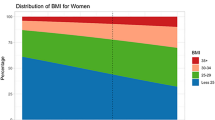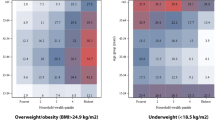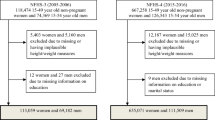Abstract
Objective: To analyse the influence of social and cultural factors in the prevalence of obesity in the Spanish adult population aged 25–60 y based on available population data.
Design: Pooled analysis of four cross-sectional nutrition surveys.
Subjects: A total of 5388 free-living subjects aged 25–60 y, respondents of the Nutritional Surveys carried out in four Spanish regions (Catalunya, Basque Country, Madrid and Valencia) from 1990 to 1994. The samples were pooled together and weighted to build a national random sample.
Measurements: Weight and height were measured on each individual by trained observers. Age, gender, educational level, occupation, habitat (rural/urban) and region were considered. Obesity was defined as body mass index ≥30 kg/m2. The protocol used in each survey was in accordance with the recommendations of the Spanish Society for the Study of Obesity (SEEDO). Logisitic regression models were designed to analyse the influence of sociodemographic factors in the prevalence of obesity in men and women.
Results: The prevalence of obesity was higher in older age groups in men and women, odds ratio (OR) for every 10 y OR=1.40 (95% CI 1.39–1.41) for men and OR=1.86 (95% CI 1.85–1.87) for women. Logisitic regression analysis adjusted for age showed higher obesity rates among low educated people, OR=1.80 (95% CI 1.78–1.81) in men and OR=2.36 (95% CI 2.29–2.42) in women (P<0.001). Among men the odds ratio for the prevalence of obesity in rural areas was OR=1.87 (95% CI 1.86–1.89), compared to cities. The geographical distribution showed higher obesity rates in the southeast.
Conclusion: This study supports that obesity is a multifactorial problem. Older women with low educational level and low income seem to be the most susceptible group to weight gain. Therefore, Public Health Programs should consider this type of environmental factor when planning strategies aimed at preventing or reducing the problem of obesity in western societies.
European Journal of Clinical Nutrition (2001) 55, 430–435
This is a preview of subscription content, access via your institution
Access options
Subscribe to this journal
Receive 12 print issues and online access
$259.00 per year
only $21.58 per issue
Buy this article
- Purchase on Springer Link
- Instant access to full article PDF
Prices may be subject to local taxes which are calculated during checkout
Similar content being viewed by others
References
Alvarez Dardet C, Alonso J, Domingo A & Regidor E (1995) La medición de la clase social en ciencias de la salud Barcelona: SG-Sociedad Española de Epidemiología
Alvarez Torices JC, Franch Nadal J, Alvarez Guisasola F, De Pablo Pons ML, Hernández Mejía R & Cueto Espinar A (1992) La obesidad en la provincia de León. Distintos criterios, diferentes prevalencias Aten Primaria 10 1013–1018
Aranceta J (1998) Epidemiología de la obesidad en los países desarrollados Nutr. Obes. 1 12–22
Aranceta J, Pérez C, Amela C & García Herrera R (1994) Encuesta de Nutrición de la Comunidad de Madrid Madrid: Consejería de Salud de la Comunidad de Madrid
Aranceta J, Pérez C, Marzana I, Egileor I, González de Galdeano L & Sáenz de Buruaga J (1995) Encuesta de nutrición de la Comunidad Autónoma Vasca. Tendencias de consumo alimentario, indicadores bioquímicos y estado nutricional de la población adulta Vitoria: Servicio de Publicaciones Gobierno Vasco
Aranceta J, Pérez C, Marzana I, Egileor I, González de Galdeano L & Sáenz de Buruaga J (1998a) Food consumption patterns in the adult population of the Basque Country (EINUT-I) Public Health Nutr. 3 185–192
Aranceta J, Pérez Rodrigo C, Serra Majem LI, Ribas L, Quiles Izquierdo J & Vioque J y cols (1998b) Prevalencia de la obesidad en España: estudio SEEDO'97 Med. Clin. (Barc.) 111 441–445
Banegas JR, Villar Alvarez F, Pérez de Andrés C, Jiménez García-Pascual R, Gil López E, Muñiz García J & Juane Sánchez R (1993) Estudio epidemiológico de los factores de riesgo cardiovascular en la población española de 35 a 44 años Rey. San. Hig. Pub. 67 419–445
Bernard Krief (1999) Informe: Estudio de costes sociales y económicos de la obesidad y sus patologías asociadas. Madrid
Birmingham CL, Muller JL, Palepu A, Spinelli JJ & Anis AH (1999) The cost of obesity in Canada Can. Med. Assoc. J. 23 483–488
Bouchard C (1996) Genetics of obesity in humans: current issues In The Origin and Consequences of Obesity CYBA Foundation Symposium 201 108–117 Chichester: Wiley
Braam LA, Ocke MC, Bueno-de-Mesquita HB & Seidell JC (1998) Determinants of obesity-related underreporting of energy intake Am. J. Epidemiol. 147 1081–1086
Bray G, Bouchard C & James WPT (1998) Definitions and proposed current classifications of obesity In Handbook of Obesity G Bray, C Bouchard & WPT James (eds) 31–40 New York: Marcel-Dekker
Caballero B (2000) Obesidad en países en transición. La obesidad como problema emergente en la salud pública de 2000 XII Congreso Latinoamericano de Nutrición Buenos Aires 12–16 November.
Coakley EH, Rimm EB, Colditz G, Kawachi I & Willet W (1998) Predictors of weight change in men: results from the Health Professionals Follow-Up Study Int. J. Obes. Relat. Metab. Disord. 22 89–96
Flegal KM, Troiano RP, Pamuk ER, Kuczmarski J & Campbell SM (1995) The influence of smoking cessation on the prevalence of overweight in the United States New Engl. J. Med. 333 1165–1170
Gutierrez-Fisac JL, Regidor E & Rodriguez C (1994) Prevalencia de obesidad en España Med. Clin. (Barc.) 102 10–13
Haapanen N, Miilunlpalo S, Pasanen M, Oja P & Vuori I (1997) Association between leisure-time physical activity and 10-year body mass change among working-aged men and women Int. J. Obes. Relat. Metab. Disord. 21 288–296
Jenicek M & Cléroux R (1987) Epidemiología. Principios, técnicas, aplicaciones Barcelona: Salvat
Khan LK & Bowman BA (1999) Obesity: a mayor global public health problem Am. Rev. Nutr. 19 13–17
Kish L (1995) Survey Sampling New York: John Wiley
Kuczmarski R, Flegal K, Campbell S & Johnson C (1994) Increasing prevalence of overweight among US adults. The National Health and Nutrition Examination Surveys, 1960 to 1991 J.A.M.A. 272 205–211
Laurier D, Guiguet M, Phong Chau N, Wells J & Valleron AJ (1992) Prevalence of Obesity: a comparative survey in France, the United Kingdom and the United States Int. J. Obes. Relat. Metab. Disord. 16 565–572
Lohman TG, Roche AF & Martorell R (1988) Anthropometric Standardisation Reference Manual Champaign, II: Human Kinetics
MacDonald SM, Reeder BA, Chen Y & Despres JP (1997) Obesity in Canada: a descriptive analysis. Canadian Heart Health Surveys Research Group Can. Med. Assoc. J. 57(Suppl 1) S3–S9
Martikainen PT & Marmot MG (1999) Socioeconomic differences in weight gain and determinants and consequences of coronary risk factors Am. J. Clin. Nutr. 69 719–726
Molarius A, Seidell JC, Kuulasmaa K, Dobson AJ & Sans S (1997) Smoking and relative body weight: an international perspective from the WHO MONICA project J. Epidemiol. Community Health 51 252–260.
Norusis MJ (1996) SPSS 7.0 Chicago, IL: SPSS, Inc.
Pi-Sunyer FX (1993) Medical hazards of obesity Ann. Intern. Med. 119 655–660
Quiles Izquierdo J & Vioque J (1996) Prevalencia de obesidad en la Comunidad Valenciana Med. Clin. (Barc.) 106 529–533
Reeder BA, Chen Y, MacDonald SM, Angel A & Sweet L (1997) Regional and rural–urban differences in obesity in Canada. Canadian Heart Health Surveys Research Group. Can. Med. Assoc. J. 57(Suppl 1) S10–S16
Rosmond R & Björntorp P (1999) Psychosocial and socio-economic factors in women and their relationship to obesity and regional body fat distribution Int. J. Obes. Relat. Metab. Disord. 23 138–145
Serra Majem L, Ribas Barba L, García Closas R et al (1996) Avaluació de l'estat nutricional de la població catalana (1992–93). Avalauació dels hàbits alimentaris, el consum d'aliments, energia i nutrients, i de l'estat nutricional mitjançant indicadors bioquímics i antropomêtrics. Barcelona: Generalitat de Catalunya Department de Sanitat i Seguretat Social
SEEDO (Sociedad Española para el Estudio de la Obesidad) (1996) Consenso español 1995 para la evaluación de la obesidad y para la realisación de estudios epidemiológicos Med. Clin. (Barc.) 107 782–787
Stam-Moraga M, Kolanowski J, Dramaix J, De Backer G & Kornitzer MD (1999) Sociodemographic and nutritional determinants of obesity in Belgium Int. J. Obes. Relat. Metab. Disord. 23(Suppl 1) S1–S9
SUDAAN (1995) SUDAAN Research Triangle Park, NC: Research Triangle Institute
Sullivan K, Kalsbeek W, Chen M & Frerichs R (1994) CSAMPLE: analysing data from complex survey samples In Epi Info, Version 6: a Word Processing, Database, and Statistics Program for Epidemiology on Microcomputers, eds. AG Dean, JA Dean, D Coulombier, KA Brendel, DC Smith, AH Burton, RC Dicker, K Sullivan, RF Fagan, TG Arner. Atlanta, GA: Center for Disease Control and Prevention
Sundquist J & Johansson SE (1998) The influence of socioeconomic status, ethnicity and lifestyle on body mass index in a longitudinal study Int. J. Epidemiol. 27 57–63
The National Heart, Lung and Blood Institute Expert Panel on the Identification, Evaluation and Treatment of Overweight and Obesity in Adults (1998) Executive summary of the clinical guidelines on the identification, evaluation, and treatment of overweight and obesity in adults J. Am. Diet. Assoc. 98 1178–1191
Tormo Díaz MJ, Navarro Sánchez C et al (1995) Factores de riesgo cardiovasculares en la Región de Murcia, 1992. Serie Informes 20. Murcia: Región de Murcia, Consejería de Sanidad y Asuntos Sociales
Van Itallie ThB (1994) Worldwide epidemiology of obesity Pharmaco Economics 5(Suppl 1) 1–7
Vioque J, Torres A & Quiles J (2000) Time spent watching television, sleep duration and obesity in adults living in Valencia, Spain Int. J. Obes. Relat. Metab. Disord. 24 1683–1688
WHO (1998) Programme of Nutrition, Family and Reproductive Health Obesity. Preventing and managing the global epidemic. Report of a WHO consultation on obesity, Geneva 3–5 June 1997. Geneva: World Health Organization
WHO Monica Project (1988) Geographical variation in the major risk factors of coronary heart disease in men and women aged 35–64 y World Health Stat. O. 41 115–140
Wolf AM & Colditz GA (1994) The cost of obesity. The US perspective PharmacoEconomics 5(Suppl 1) 34–37
Acknowledgements
JV was supported by a grant fromt the Fondo Investigación Sanitaria (FIS 00/0985).
Author information
Authors and Affiliations
Consortia
Corresponding author
Rights and permissions
About this article
Cite this article
Aranceta, J., Perez-Rodrigo, C., Serra-Majem, L. et al. Influence of sociodemographic factors in the prevalence of obesity in Spain. The SEEDO'97 Study. Eur J Clin Nutr 55, 430–435 (2001). https://doi.org/10.1038/sj.ejcn.1601189
Received:
Revised:
Accepted:
Published:
Issue Date:
DOI: https://doi.org/10.1038/sj.ejcn.1601189
Keywords
This article is cited by
-
Socio-Behavioral Factors Associated with Overweight and Central Obesity in Tehranian Adults: a Structural Equation Model
International Journal of Behavioral Medicine (2017)
-
Unconditional quantile regressions to determine the social gradient of obesity in Spain 1993–2014
International Journal for Equity in Health (2016)
-
A Spatial Econometric Analysis of Adult Obesity: Evidence from Canada
Applied Spatial Analysis and Policy (2016)
-
The impact of maternal obesity on iron status, placental transferrin receptor expression and hepcidin expression in human pregnancy
International Journal of Obesity (2015)
-
Obesity prevalence from a European perspective: a systematic review
BMC Public Health (2008)



